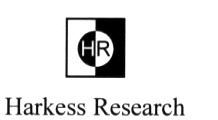
 Wisp
Unification Theory - 6 Electromagnetic Force
Wisp
Unification Theory - 6 Electromagnetic Force
- Home
- About Me
- Reason why Einstein was wrong
- One-way speed of light experiments
- Hot topic
- Q&A
- ACES - The end of Relativity
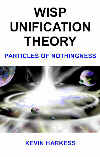
- Book Contents
- Introduction
- 1 Matter,Space and Time
- 2 Symmetry
- 3 Fractals
- 4 Wisp Space
- 5 Gravity
- 6 Electromagnetic Force
- 7 Wisp & S.R: Fundamentals
- 8 Wisp & S.R: Electrodynamics
- 9 Wisp & S.R: Doppler effect
- 10 Wisp & S.R: Relativistic Mechanics
- 11 Big bang
- Appendix A
- Appendix B
- Index A-Z
- Copyright
- Feedback
This page contains the complete chapter. To download the new 2011 2nd edition of wisp unification theory go to the homepage.
6
Electromagnetic Force
Electromagnetic force has two components, one electric and the other
magnetic.
In his special theory of relativity, Einstein showed that their effects
are identical, and it is an observer’s frame of reference that determines
which of the two causes an effect. An effect that appears as magnetic
to one observer may appear as electric to another observer.
Although wisp theory and special relativity differ fundamentally, they
do agree on this point, which we will cover in Chapter 8 when comparing
wisp theory with special relativity in ‘Wisp and Special Relativity:
Electrodynamics’. But for now we will keep things simple.
Wisp theory suggests that it is distortions to a charged body’s electric
field shape that create the effect of magnetic force.
6.1 Electric force
Matter-fractals (fundamental particles) that are not spherically symmetric
have structures that create asymmetry in the surrounding wisp space. This
produces a slight twist in the surrounding layers – shells –
of wisps, and these spiral either clockwise or anticlockwise, widening
the gaps between neighbouring wisps, which create the positive or negative
electric charge effect (Figure 6.1).
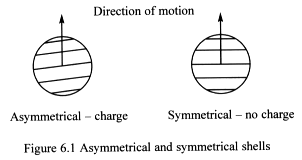
It is important to understand that it is a physical change brought about
by asymmetry in the matter-fractal’s structure that creates the electric
charge effect.
Forces in wisp space act at all times to restore the order of symmetry.
So that when ‘twisted’ clockwise and anticlockwise wisp space
meet, forces act to restore symmetry to flat one-state space, cancelling
their charge effects.
As charged particles move through wisp space their symmetry axes line
up with their directions of motion, and wisp space displacement takes
place in the normal manner. However, the particles’ electric charges
have fine spiral structures that rotate as they move through wisp space.
We can think of them as rotating electric charge patterns, which are likened
to radial spokes in rotating wheels. The wisps through which they pass
are not rotated but get displaced at right angles to the patterns’
motions.
6.2 Magnetic force
As a matter-fractal moves through wisp space it displaces wisps at right
angles to its direction of motion.
Similarly, when a charged particle’s electric field moves, only its
rotating pattern moves through wisp space. It is the rotating electric
field pattern that forms the magnetic field lines which circle the moving
charged particle. And because magnetic field lines are cause by rotation,
they are continuous, i.e. they have no beginning or end points.
In order for a magnetic force to occur between two charged particles,
the following conditions must apply:
- A charged particle must move through wisp space to create a rotating electric field pattern – a magnetic field.
- A second rotating electric field pattern – magnetic field – must be present for the two field patterns to interact and produce a magnetic force between the charged particles, as wisp space alone does not interact with the distorted electric fields that are responsible for causing the magnetic force.
Figure 6.2 shows a charged particle moving into the page. We concentrate on the two wisps shown as small dark circles that lie on the large circle representing the particle’s rotating electric field pattern. A second charged particle (not shown) produces an electric field pattern that moves with speed v, as shown in the figure. The two wisps shown move transversely (across the page from side to side as the particle’s shape displaces them) to the charged particle’s motion. At the points selected they move in opposite directions and at right angles to the rotating electric field patterns.
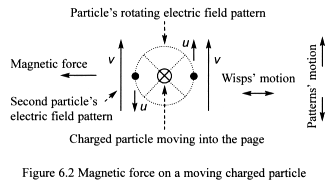
By summing the speeds of the patterns together, their effect on wisp
space can be determined. As the patterns move through wisp space they
displace its wisps slightly. The two wisps shown in the figure are displaced
by different amounts and so experience different forces, because the sum
of the patterns’ speeds passing them are different, (v + u)
and (v - u) respectively. And since the wisps move in opposite
directions, a net magnetic force results, which acts on the charged particle.
In Chapter 8 we will look at the formal relationship between the electric
and magnetic force for moving charged particles.
6.3 Light
Light is electromagnetic radiation that carries energy through wisp space
in the form of oscillating electric and magnetic fields – electromagnetic
waves (Figure 6.3).
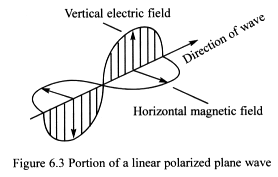
In one-state wisp space these fields are at right angles to each other
and to the direction of propagation. In the figure, gaps in wisp space
lie in a vertical plane creating an electric field pattern (vertically
polarised light). The changes in motion of the electric field pattern
(oscillations up and down) cause a magnetic field effect at right angles
to it, and vice versa. The principle of least action ensures that minimal
disruption occurs in wisp space if the magnetic field develops this way.
The energy of electromagnetic radiation can also be regarded as a stream
of photons that travel through wisp space at the speed of light. Just
as electromagnetic waves can propagate only as whole waves – it is
not possible for a fraction of a wave to move independently. Similarly,
photons can only have quantum units of energy – their values can
only be a multiple of a fixed amount. Properties of wisp space ensure
that the waves’ amplitudes remain constant.
An electron emits or absorbs photons when it jumps between energy levels
in an atom. If the positive charge at the atom’s nucleus twists clockwise
and the electron’s charge twists anticlockwise then the electric
charge effect will cancel out when they meet.
If an electron is knocked towards an atom’s nucleus, it is able to
neutralise the atom’s positive charge while occupying a smaller volume
of space. So it must emit some of its outer structure, making it smaller.
It does so by ejecting a layer of its twisted charge pattern. This layer
moves away as a plane of electric charge forming an electromagnetic wave
– a photon.
But if it emits a layer of its outer charge pattern, why does the charge
on an electron stay constant?
Well, its charge is determined fundamentally by the twist in its fractal
structure – a physical thing – and this stays the same, even
though its outer charge pattern – a non-physical thing – changes
as it emits and absorbs photons.
6.3.1 Zero rest mass
A particle possesses mass because its spherical fractal structure locks
on to a specific number of wisps, and these possess mass. But light does
not possess a spherical fractal structure because it does not have a central
zero-state sphere, and so it has zero rest mass.
Home --
About Me -- Reasons
why Einstein was wrong -- One-way
speed of light experiments -- Hot
topic --
Q&A -- ACES
- The end of Relativity --
Book Contents -- Introduction
-- 1 Matter,
Space and Time -- 2
Symmetry -- 3
Fractals -- 4 Wisp Space
-- 5 Gravity -- 6
Electromagnetic Force --
7 Wisp & S.R: Fundamentals
-- 8 Wisp & S.R: Electrodynamics
-- 9 Wisp
& S.R: Doppler effect -- 10
Wisp & S.R: Relativistic Mechanics --
11 Big bang -- Appendix
A -- Appendix B -- Index
A-Z -- Copyright -- Feedback